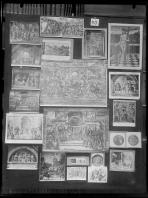The panel is dominated by two large images, positioned in the center and surrounded by a wreath of smaller photographs. The overall layout thus creates an impression of order, yet also has a polarizing effect, bringing to mind hangings of gallery interiors from the 17th century where images were similarly hung as pendants, complementing each other stylistically and iconographically. Two images by the same artist – Ghirlandaio – and from the same chapel – the Cappella Maggiore in S. Maria Novella, Florence – are juxtaposed here. However, the effect of each image is rather different. While the cruel depiction of the Massacre of the Innocents (#10) is an outburst of superlative forms of emotion called “triumphal-arch pathos” (Werke, 301) by Warburg, these fierce and agitated antique elements are lacking in the solemn scene of the Apparition of the Angel to Zecharias (#4.2). Here, Ghirlandaio proves rather to be the “calm, almost steadfast portrait painter of rich citizens” (Bauerle). Here, the violent antique heritage is metonymically relegated to the architectural background and its Dionysian psychic energy is curtailed in the literally bloodless form of a grisaille. Nonetheless, this balanced and controlled expression of pathos-charged energies from antiquity is also ostensibly at risk here, given its polar counterpart, the Apparition. The grisailles, dubbed “energetic symbols of balance” by Warburg, are stepping out of the frame of the triumphal arch in the Massacre, coming to life and intruding into our, present-day visual space.
